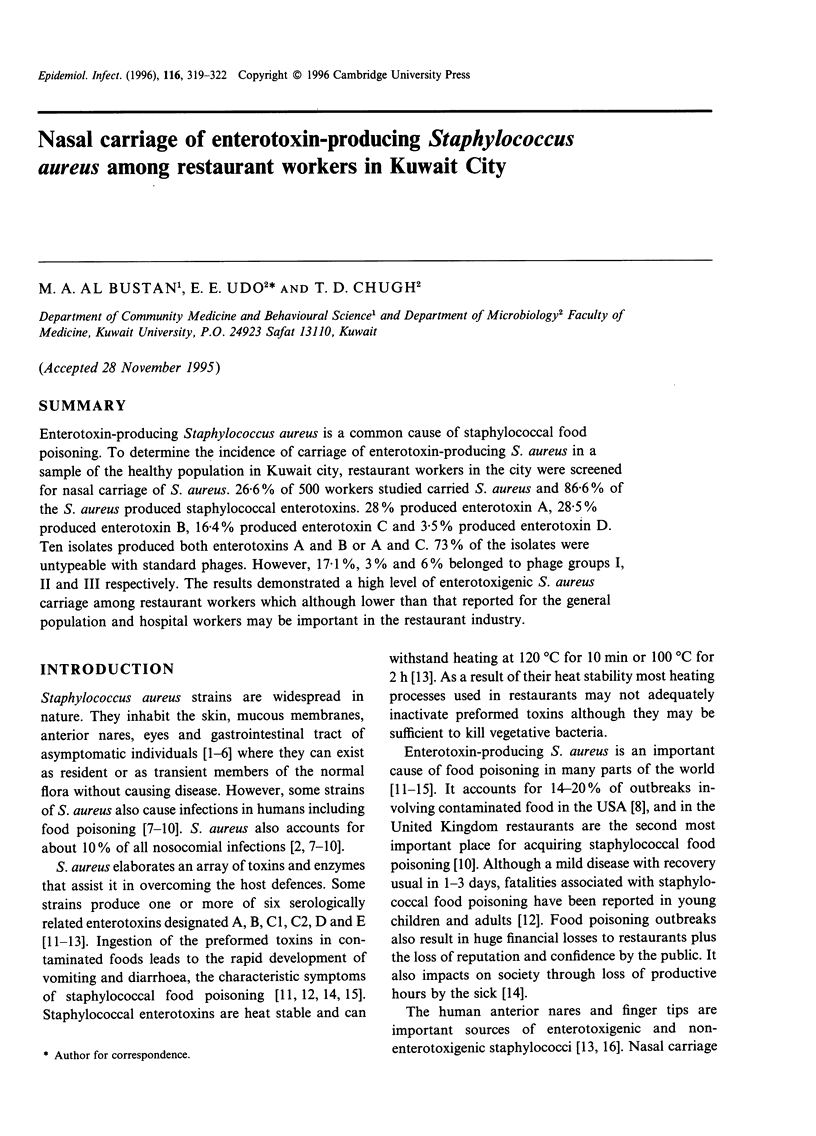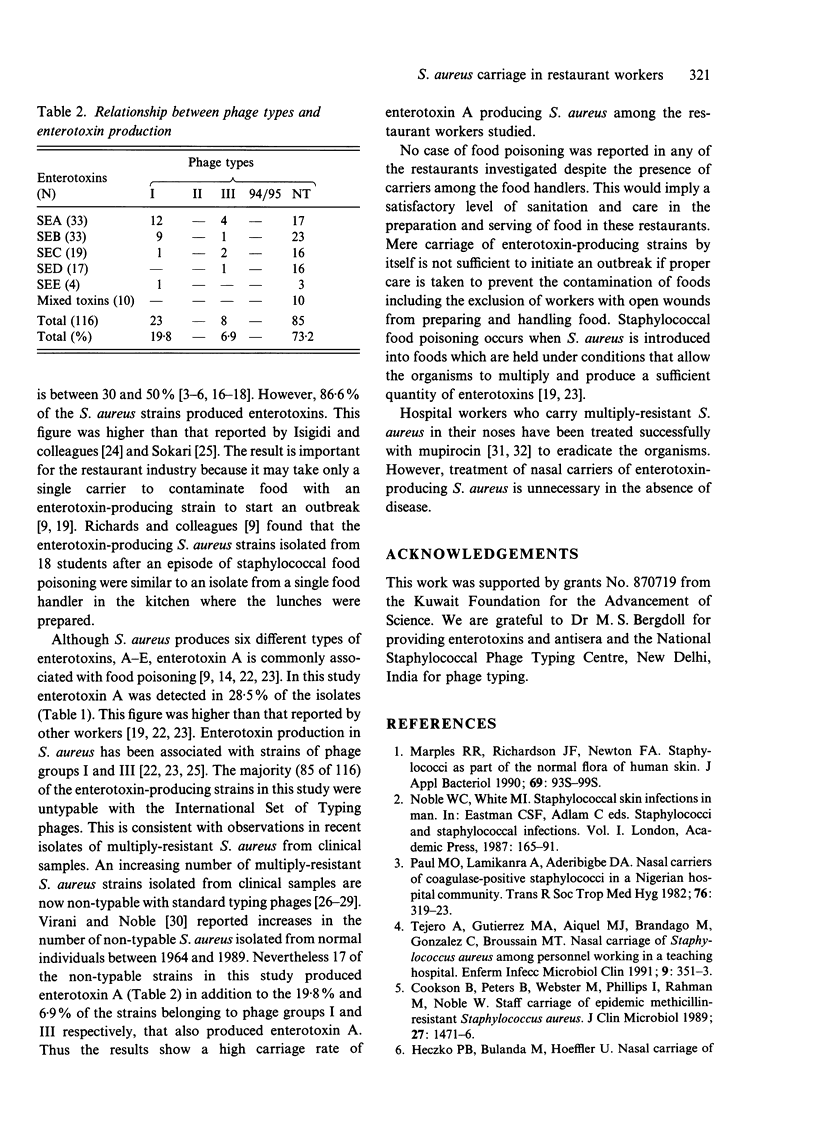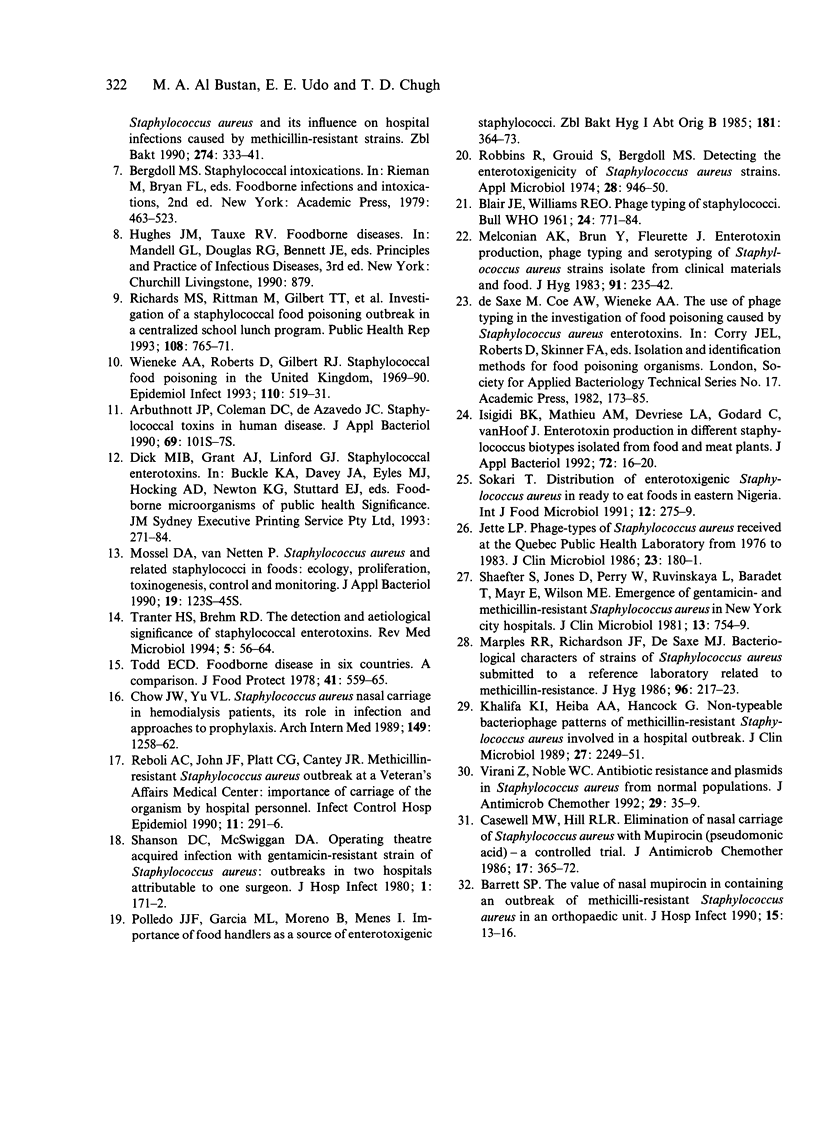Abstract
Enterotoxin-producing Staphylococcus aureus is a common cause of staphylococcal food poisoning. To determine the incidence of carriage of enterotoxin-producing S. aureus in a sample of the healthy population in Kuwait city, restaurant workers in the city were screened for nasal carriage of S. aureus. 26.6% of 500 workers studied carried S. aureus and 86.6% of the S. aureus produced staphylococcal enterotoxins. 28% produced enterotoxin A, 28.5% produced enterotoxin B, 16.4% produced enterotoxin C and 3.5% produced enterotoxin D. Ten isolates produced both enterotoxins A and B or A and C. 73% of the isolates were untypeable with standard phages. However, 17.1%, 3% and 6% belonged to phage groups I, II and III respectively. The results demonstrated a high level of enterotoxigenic S. aureus carriage among restaurant workers which although lower than that reported for the general population and hospital workers may be important in the restaurant industry.
Full text
PDF



Selected References
These references are in PubMed. This may not be the complete list of references from this article.
- Arbuthnott J. P., Coleman D. C., de Azavedo J. S. Staphylococcal toxins in human disease. Soc Appl Bacteriol Symp Ser. 1990;19:101S–107S. doi: 10.1111/j.1365-2672.1990.tb01802.x. [DOI] [PubMed] [Google Scholar]
- Casewell M. W., Hill R. L. Elimination of nasal carriage of Staphylococcus aureus with mupirocin ('pseudomonic acid')--a controlled trial. J Antimicrob Chemother. 1986 Mar;17(3):365–372. doi: 10.1093/jac/17.3.365. [DOI] [PubMed] [Google Scholar]
- Chow J. W., Yu V. L. Staphylococcus aureus nasal carriage in hemodialysis patients. Its role in infection and approaches to prophylaxis. Arch Intern Med. 1989 Jun;149(6):1258–1262. [PubMed] [Google Scholar]
- Cookson B., Peters B., Webster M., Phillips I., Rahman M., Noble W. Staff carriage of epidemic methicillin-resistant Staphylococcus aureus. J Clin Microbiol. 1989 Jul;27(7):1471–1476. doi: 10.1128/jcm.27.7.1471-1476.1989. [DOI] [PMC free article] [PubMed] [Google Scholar]
- Francisco Polledo J. J., García M. L., Moreno B., Menes I. Importance of food handlers as a source of enterotoxigenic staphylococci. Zentralbl Bakteriol Mikrobiol Hyg B. 1985 Dec;181(3-5):364–373. [PubMed] [Google Scholar]
- Isigidi B. K., Mathieu A. M., Devriese L. A., Godard C., Van Hoof J. Enterotoxin production in different Staphylococcus aureus biotypes isolated from food and meat plants. J Appl Bacteriol. 1992 Jan;72(1):16–20. doi: 10.1111/j.1365-2672.1992.tb04875.x. [DOI] [PubMed] [Google Scholar]
- Jetté L. P. Phage types of Staphylococcus aureus received at the Quebec Public Health Laboratory from 1976 to 1983. J Clin Microbiol. 1986 Jan;23(1):180–181. doi: 10.1128/jcm.23.1.180-181.1986. [DOI] [PMC free article] [PubMed] [Google Scholar]
- Khalifa K. I., Heiba A. A., Hancock G. Nontypeable bacteriophage patterns of methicillin-resistant Staphylococcus aureus involved in a hospital outbreak. J Clin Microbiol. 1989 Oct;27(10):2249–2251. doi: 10.1128/jcm.27.10.2249-2251.1989. [DOI] [PMC free article] [PubMed] [Google Scholar]
- Marples R. R., Richardson J. F., Newton F. E. Staphylococci as part of the normal flora of human skin. Soc Appl Bacteriol Symp Ser. 1990;19:93S–99S. doi: 10.1111/j.1365-2672.1990.tb01801.x. [DOI] [PubMed] [Google Scholar]
- Marples R. R., Richardson J. F., de Saxe M. J. Bacteriological characters of strains of Staphylococcus aureus submitted to a reference laboratory related to methicillin resistance. J Hyg (Lond) 1986 Apr;96(2):217–223. doi: 10.1017/s0022172400065980. [DOI] [PMC free article] [PubMed] [Google Scholar]
- Melconian A. K., Brun Y., Fleurette J. Enterotoxin production, phage typing and serotyping of Staphylococcus aureus strains isolated from clinical materials and food. J Hyg (Lond) 1983 Oct;91(2):235–242. doi: 10.1017/s0022172400060241. [DOI] [PMC free article] [PubMed] [Google Scholar]
- Mossel D. A., van Netten P. Staphylococcus aureus and related staphylococci in foods: ecology, proliferation, toxinogenesis, control and monitoring. Soc Appl Bacteriol Symp Ser. 1990;19:123S–145S. doi: 10.1111/j.1365-2672.1990.tb01804.x. [DOI] [PubMed] [Google Scholar]
- Norrby S. R. Challenges in the design of trials to evaluate antibacterial agents in serious infections. J Hosp Infect. 1990 Apr;15 (Suppl A):13–21. doi: 10.1016/0195-6701(90)90075-y. [DOI] [PubMed] [Google Scholar]
- Paul M. O., Lamikanra A., Aderibigbe D. A. Nasal carriers of coagulase-positive staphylococci in a Nigerian hospital community. Trans R Soc Trop Med Hyg. 1982;76(3):319–323. doi: 10.1016/0035-9203(82)90180-8. [DOI] [PubMed] [Google Scholar]
- Reboli A. C., John J. F., Jr, Platt C. G., Cantey J. R. Methicillin-resistant Staphylococcus aureus outbreak at a Veterans' Affairs Medical Center: importance of carriage of the organism by hospital personnel. Infect Control Hosp Epidemiol. 1990 Jun;11(6):291–296. doi: 10.1086/646174. [DOI] [PubMed] [Google Scholar]
- Richards M. S., Rittman M., Gilbert T. T., Opal S. M., DeBuono B. A., Neill R. J., Gemski P. Investigation of a staphylococcal food poisoning outbreak in a centralized school lunch program. Public Health Rep. 1993 Nov-Dec;108(6):765–771. [PMC free article] [PubMed] [Google Scholar]
- Robbins R., Gould S., Bergdoll M. Detecting the enterotoxigenicity of Staphylococcus aureus strains. Appl Microbiol. 1974 Dec;28(6):946–950. doi: 10.1128/am.28.6.946-950.1974. [DOI] [PMC free article] [PubMed] [Google Scholar]
- Schaefler S., Jones D., Perry W., Ruvinskaya L., Baradet T., Mayr E., Wilson M. E. Emergence of gentamicin- and methicillin-resistant Staphylococcus aureus strains in New York City hospitals. J Clin Microbiol. 1981 Apr;13(4):754–759. doi: 10.1128/jcm.13.4.754-759.1981. [DOI] [PMC free article] [PubMed] [Google Scholar]
- Shanson D. C., McSwiggan D. A. Operating theatre acquired infection with a gentamicin-resistant strain of Staphylococcus aureus: outbreaks in two hospitals attributable to one surgeon. J Hosp Infect. 1980 Jun;1(2):171–172. doi: 10.1016/0195-6701(80)90050-x. [DOI] [PubMed] [Google Scholar]
- Sokari T. Distribution of enterotoxigenic Staphylococcus aureus in ready-to-eat foods in eastern Nigeria. Int J Food Microbiol. 1991 Feb;12(2-3):275–279. doi: 10.1016/0168-1605(91)90079-5. [DOI] [PubMed] [Google Scholar]
- Tejero A., Gutiérrez M. A., Aiquel M. J., Brandago M., González C., Broussain M. T. Portación nasal de Staphylococcus aureus en personal que trabaja en un centro asistencial-docente. Enferm Infecc Microbiol Clin. 1991 Jun-Jul;9(6):351–353. [PubMed] [Google Scholar]
- Virani Z., Noble W. C. Antibiotic resistance and plasmids in Staphylococcus aureus from normal populations. J Antimicrob Chemother. 1992 Jan;29(1):35–39. doi: 10.1093/jac/29.1.35. [DOI] [PubMed] [Google Scholar]
- Wieneke A. A., Roberts D., Gilbert R. J. Staphylococcal food poisoning in the United Kingdom, 1969-90. Epidemiol Infect. 1993 Jun;110(3):519–531. doi: 10.1017/s0950268800050949. [DOI] [PMC free article] [PubMed] [Google Scholar]


